| Bellumori |
Berruti |
Breithaupt |
Brown |
Darocki | Ernst |
| Flynn |
Golwala |
Joerger |
Kostielney |
Mahmoud |
|
| McHugh |
Sherrod |
Turner |
Wheatley |
Ziminski |
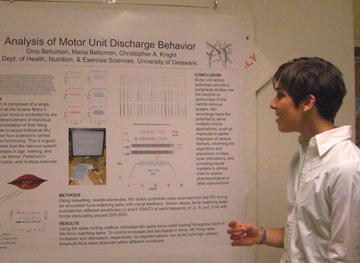 Analysis of Motor Unit Discharge Behavior Gina M. Bellumori, Maria Bellumori, Christopher A. Knight Department of Health, Nutrition, and Exercise Science A motor unit (MU) is comprised
of a single motor neuron and all the
muscle fibers it innervates. Muscular force is controlled by the
recruitment and derecruitment of individual MUs and by the modulation
of their firing rates. It is possible to record individual MU spike
trains to view how a person’s central nervous system is functioning.
This is also a good method to determine how the nervous system operates
with changes in age, training, and pathologies such as tremor,
Parkinson’s disease, cerebral palsy, and multiple sclerosis. Methods:
Using indwelling, needle electrodes, MU action potentials were recorded
from the FDI during six sinusoidal force matching tasks with visual
feedback (n=18, >150 MU observations). Force matching tasks involved
two amplitudes (3 and 6 %MVC) at each frequency of .3, .6, and .9 Hz
with forces modulating around 20% MVC. Results: Using the spike sorting
method, individual MU spike trains were tracked throughout each of the
force matching tasks. To control increases and decreases in force, MU
firing rates increased and decreased, respectively. Low (tonic) and
high (phasic) threshold MUs were observed within different conditions.
Conclusion: Motor unit action potentials provide a peripheral window
into the function or dysfunction of the central nervous system. MU
recordings also have the potential to serve clinical applications, such
as improved or earlier diagnosis of various tremors, informing the
algorithms and placement of deep brain stimulators, and providing
neural markers in clinical trials to assess pharmacological or other
interventions.
|
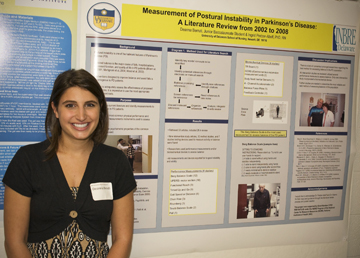 Measurements of Postural Instability in Parkinson’s Disease: A Literature Review from 2002 to 2008 Deanna J. Berruti and Ingrid Pretzer-Aboff University of Delaware School of Nursing, Newark, DE 19716 Postural instability is a
hallmark feature of Parkinson’s disease (PD).
Impaired balance is the major cause of falls and one of the main
reasons for hospitalization in PD (Wood et al, 2002). Furthermore, poor
balance often leads to a significant decrease in function and quality
of life (Bloem et al, 2001; Martignoni et al, 2004). Interventions
designed to improve balance and avoid falls are advantageous to PD
patients. In order to adequately assess the effectiveness of proposed
interventions, it is imperative to use the most appropriate measurement
tools. The purpose of this review is to evaluate the current literature
with regard to the most common physical performance and biomechanical
measurement instruments used to assess balance in PD patients. The
literature review searched all publications from 2002 to 2008. The
keywords used were: Parkinson’s disease (PD), Ambulation, Balance,
Tinetti Balance Scale, Postural stability, Exercise and PD, Home
setting- therapy, Berg Balance Scale (BBS). The databases searched
included PubMed, Medline, PsychInfo, and CINAHL. Thirty three
references were retrieved, 28 were pertinent and sorted into three
categories: 1) Measurements used in Intervention studies, 2) Methods
articles, and 3) Biomechanical device studies. We found that the Berg
Balance Scale was the most utilized and tested method for assessing
balance in the PD patient. There were few studies using biomechanical
devices to test balance impairment in this population. More research is
needed in this area.
This project described was supported by Grant Number 2 P20 RR016472-08
under the INBRE Program of the National Center for Research Resources
(NCRR), National Institutes of Health (NIH).
|
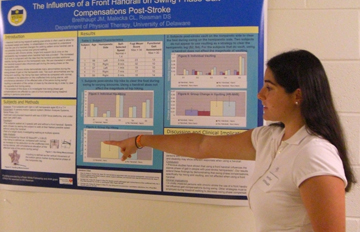 The Influence of a Front Handrail on Swing Phase Gait Compensations Post-Stroke Jennifer M. Breithaupt, Christine L. Malecka, and Darcy S. Reisman Department of Physical Therapy In rehabilitation it is
important to understand how the use of a
handrail for increased speed and safety changes the walking pattern.
Persons with chronic stroke demonstrate many abnormalities during the
swing phase of gait on the hemiparetic side including hip hiking, an
increase in hip abduction on the unaffected limb, and vaulting,
elevation of the center of mass by the stance leg to clear the opposite
food during swing. The purpose of this study is to investigate how
swing phase gait compensations are affected by use of a front handrail
during treadmill walking in persons post-stroke. Five subjects with
right or left hemiparesis ages 63.4 ± 7.4 walked at 2 speeds
with and
without a front handrail and were asked to walk at their fastest
possible speed without using the handrail. The results showed that
using a handrail does not affect the magnitude of hip hiking or of
vaulting. Previous studies have shown that using a front handrail
influences the stance phase of gait in people with post-stroke
hemiparesis. Our results extend these findings by demonstrating that
swing phase compensations, specifically hip hiking and vaulting, are
not affected when using a front handrail. Our results were in subjects
who were at least limited community ambulators. Thus, persons with
chronic post-stroke hemiparesis with greater gait impairment may show
different responses when using a handrail. Funding provided by a Peter
White Fellowship and AHA grant 0765314U.
|
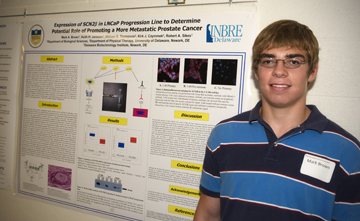 Expression of SCN2β in LNCaP Progression Line to Determine Potential Role of Promoting a More Metastatic Prostate Cancer Mark A. Brown1, Keith Jansson1, William R. Thompson2, Kirk J. Czymmek3, Robert A. Sikes1 1Department of Biological Sciences, 2Department of Physical Therapy, 3Delaware Biotechnology Institute The function of voltage-gated
sodium channels has been well
characterized, however its potential role in producing a more
metastatic phenotype of prostate cancer (PCa) is not well known.
beta-subunits of sodium channels have immunoglobulin (Ig) loops of the
V-set family that are known to interact homotypically and
heterotypically as cellular adhesion molecules. We hypothesize that the
beta subunits contribute to metastasis to the spine through perineural
invasion by interacting with other V-set Ig-molecules. Western Blot for
the SCN2beta subunit was performed on cells of the isogenic human PCa
progression model: LNCaP, C4-2, and C4-2B4. Imunofluorescence also was
performed on the C4-2B4 cell line. Digitonin-derived whole cell
extracts from C4-2 cells were subjected to a wheat germ agglutinin
(lectin) affinity column to enrich SCN2beta in the samples for western
blot analysis. Western Blot analysis of the cells of the LNCaP PCa
progression series showed an increasing expression of SCN2beta that
corresponded to increasing tumorigenicity, invasiveness and metastatic
potential. The protein was found predominantly in triton soluble
fractions. Immunofluorescence showed little specific interaction. The
C4-2 lysate subjected to lectin chromatography showed little SCN2beta.
Although the results of the immunoblot suggest that the expression of
SCN2beta increases as PCa progresses to a more metastatic phenotype,
the functional significance of its location in triton soluble fractions
remains to be determined. Additional troubleshooting or affinity
purification of the antibody may be for specificity. Preliminary
results with lectin chromatography were disappointing but this method
may still prove efficient for enriching beta-subunits. Funded by the
INBRE Program- P20RR016472.
|
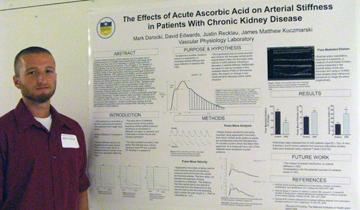 The Effects of Acute Ascorbic Acid on Arterial Stiffness in Patients With Chronic Kidney Disease. Mark Darocki, David Edwards, Justin Recklau, and James Matthew Kuczmarski Department of Health, Nutrition, and Exercise Science Chronic Kidney Disease (CKD)
patients are at a higher risk of
cardiovascular (CV) mortality than progressing to end stage renal
disease, and their risk of CV disorders is greater than would be
predicted by traditional risk factors. The increase in CV disease in
these patients may be the result of arterial stiffness secondary to
endothelial dysfunction as a result of oxidative stress. To determine
if oxidative stress is the mechanism underlying endothelial dysfunction
and arterial stiffness, CKD patients and healthy control subjects are
being administered acute intravenous infusions of saline or a
supraphysiological dose of ascorbic acid, a potent antioxidant.
Infusions are being performed in random order and the ascorbic acid
dose is based on each subject’s fat free mass (FFM). Baseline and post
infusion measurements of aortic augmentation index (AI), an index of
wave reflection, and carotid-femoral pulse wave velocity (PWV) are
being recorded using non-invasive applanation tonometry. Additionally,
brachial artery flow mediated dilation (FMD), a measurement of
endothelial dysfunction, is being assessed using high resolution
ultrasound. To date baseline data has been collected on 9 CKD patients
(age 62 ± 12 yr; 4 men, 5 women). We have found an AI of 25.4
± 14.4 %,
PWV of 7.9 ± 1.4 m/s, and FMD of 4.3 ± 2.2 % in this
group of CKD
patients. Infusion studies are ongoing and we hypothesize that ascorbic
acid will increase FMD resulting in lower PWV and AI in CKD patients.
Source of Funding: National Institutes of Health DK077306
|
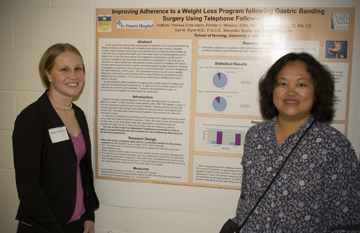 Improving Adherence to a Weight Loss Program Following Gastric Banding Surgery Using Telephone Consultations Theresa A. Ernst, Erlinda C. Wheeler, Thomas L. Hardie, Gail M. Wynn M.D., and Maryellen D. Sparks Department of Nursing and St. Francis Hospital In the recent decades obesity
has become an epidemic. Due to the
overwhelming effects of obesity on mortality and morbidity more people
are turning to bariatric surgery. Recent studies have shown that
patients who consistently attend follow-up visits with their surgeon
and health care team were more successful with long-term weight loss.
It has also been shown that telephone consultations can be used to
increase compliance and decrease post-operative complications. Our goal
was to determine if regular telephone consultations would increase
compliance with follow-up appointments and therefore lead to improved
bariatric surgery outcomes. Patients undergoing pre-operative
counseling were consented and then randomly assigned to the
experimental or control group. The experimental group would receive
weekly telephone consultations encouraging them to attend follow-up
appointments and addressing any questions. The control group would
receive standard care post bariatric surgery. A power analysis
determined that the appropriate sample size is 64 patients for both the
control and experimental group. To date only 39 out of the required 128
patients are 6 months post-operation. Therefore, the preliminary
results are inconclusive and research is continuing to be conducted.
This project described was supported by Grant Number 2 P20 RR016472-08
under the INBRE Program of the National Center for Research Resources
(NCRR), National Institutes of Health (NIH).
|
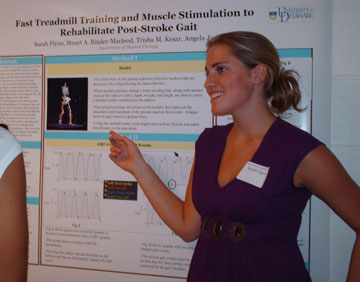 Fast Treadmill Training and Muscle Stimulation to Rehabilitate Post-Stroke Gait Sarah C. Flynn, Stuart A. Binder-Macleod, Trisha Kesar, and Angela Jancosko Department of Physical Therapy Regaining the ability to walk
is a crucial component of stroke
survivors’ rehabilitation. A recently funded NIH project, FastFES,
combines fast treadmill training with functional electrical stimulus
(FES) to improve the gait pattern of individuals who have suffered a
stroke. Stroke subjects often experience an asymmetrical gait pattern
due to the paretic leg’s decreased knee flexion and ankle dorsiflexion
during the swing phase, and decreased hip extension during terminal
stance. Stroke subjects also tend to walk at a slow speed and spend a
decreased amount of time on their paretic leg. By training subjects at
a faster pace, subjects will walk more symmetrically than at their
self-selected pace and achieve greater hip extension. Stimulating the
plantar of the paretic leg will increase the force generated at toe-off
of the paretic leg to increase the knee flexion during swing, creating
a more normal and efficient swing phase. Stimulating the dorsiflexors
of the paretic leg will increase ankle dorsiflexion during swing phase
to create a more efficient swing phase for that leg. The stance and
swing phases of gait must be accurately identified to objectively
evaluate each subject’s gait deviations and responses to treatment,. My
role in this project has been to identify heel strike and toe off using
Visual 3D Software to evaluate kinetic and kinematic data. Funding for
this research has been provided by NIH Grant R01 NR010786 and the
University of Delaware’s Science and Engineering Scholarship.
|
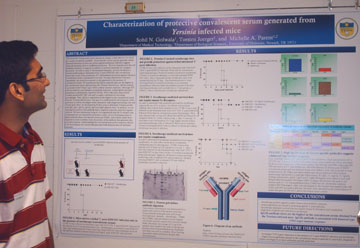 Characterization of Protective Convalescent Serum generated from Yersinia-infected Mice Sohil N. Golwala, Torsten A. Joerger, and Michelle A. Parent Department of Medical Technology The bacterium Yersinia pestis causes pneumonic
plague, a fatal
infection for which no vaccine is currently available. Given that the
current vaccine generates robust humoral immunity yet does not protect
against pneumonic infection suggests humoral immunity alone is
insufficient protection. We have hypothesized that cell-mediated
immunity is required in addition to humoral immunity for complete
protection. In order to study T cell mediated immunity, we have
developed a vaccine model using an attenuated strain Y. pestis KIM D27
and convalescent serum that results in the production of T
cell-meditated protection against infection. Convalescent serum is
produced by low-dose Yersinia
infected mice and most importantly, this
protective response is only generated in the presence of convalescent
serum. Our goal is to understand the development of this protection as
well as investigate serum interaction with antigen-presenting cells and
Yersinia pestis. Here,
we developed an ELISA assay to determine Yersinia specific total
IgG, IgG1, IgG2a, IgG2b, IgG3 and IgM antibody
titers. In addition, we are studying the portion of the antibody that
is required to provide protection against infection. We have determined
using in vivo experiment that the Fc receptor is not required for
protection. Lastly, we are developing assays to digest antibodies from
convalescent serum into F(Ab)’2 and column purify these fragments in
order to further study the portion of the antibody that generates this
protective response. Understanding this cell-mediated protective
response will aid in the development of a vaccine that generates both
humoral and cell-mediated immunity.
|
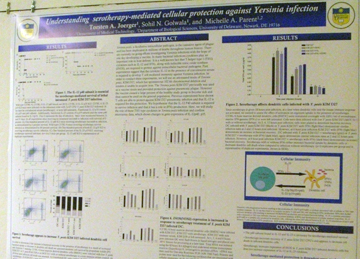 Understanding serotherapy-mediated cellular protection against Yersinia infection Yersinia pestis, a facultative
intracellular pathogen, is the causative
agent of plague and has been implicated in millions of deaths
throughout human history. There are currently on going efforts
investigating Yersinia
infections with the hope of one day developing a
vaccine. In many bacterial infections cytokines play an important role
in host defense. It is a well known fact that TH1 cytokines such as
IL-12 and IFN-gamma are required to protect against intracellular
bacterial pathogens. Past experiments suggest that the cytokine IL-12
in the presence of convalescent serum is required to develop T cell
mediated immunity against Yersinia
infection. In order to conduct these
experiments, we will use an attenuated strain of Yersinia pestis, KIM
D27, which has spontaneous 102 kb chromosomal deletion and renders it
unable to acquire iron. The Yersinia
pestis KIM D27 previously was used
as a vaccine strain and provided protection against pneumonic plague.
However the vaccine caused a large percent of the healthy study group
to become sick and thus cannot be used on the general population.
Previous experiments have shown T cells are able to protect against KIM
D27 pneumonic infection and that IL-12 is required for this protection.
We hypothesize that the IL-12 P40 subunit is required to survive
infection and that it has a role in IFN production. Here, we will
study the role of these TH1 type cytokines in Yersinia pestis infection
and confirm microarray data, which shows changes in gene expression of
IL-12p40, p35.
|
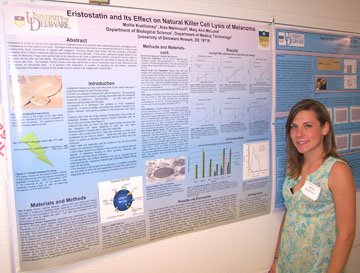 Eristostatin and Its Effect on Natural Killer Cell Lysis with Melanoma Mollie C. Kostielney and Mary A. McLane Department of Medical Technology Melanoma is a form of cancer
that originates as a malignant tumor from
pigment cells called melanocytes and aggressively metastasizes to other
parts of the body. Disintegrins are composed of short amino acid
sequences that bind to integrins and subsequently block interactions of
ligands with receptors. Previous studies have shown that the
disintegrin eristostatin increases lysis of SBcl2 melanoma cells by
natural killer-like TALL-104 cells. In this study, cytotoxicity assays
based on the release of adenylate kinase were performed on six melanoma
cell lines to determine whether eristostatin has the ability to
increase natural killer cell lytic ability. We expect that eristostatin
will increase the lytic ability of natural killer cells on melanoma.
Cell surface marker studies were also performed on all six melanoma
lines to help characterize the mechanism of enhanced lysis. It is
possible that eristostatin is capable of changing the cell surface
repertoire. Understanding eristostatin’s impact on the innate immune
system is an integral part of this project.
|
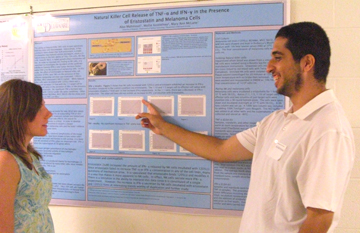 Natural Killer Cell Secretion of TNF-α and IFN-γ in the Presence of Eristostatin and Melanoma Cells Alaa Mahmoud and Mary Ann McLane Department of Medical Technology The ability of Natural Killer
(NK) cells to lyse cancerous cells has
been well documented. Interestingly, it has previously been shown that
4μM eristostatin, a snake (Eristocophis macmahoni) venom disintegrin,
elicits a 2-fold increase in the lytic ability of TALL-104 cells,
NK-like cells, towards SBcl2, a radial growth phase melanoma cell line.
In order to translate this finding to NK cells, it is important to
investigate the secretion of the cytokines Interferon-Gamma (IFN-γ) and
Tumor Necrosis Factor-alpha (TNF-α) in the presence of melanoma cells.
In this study, the effect of Eristostatin on Natural Killer cell
secretion of IFN-γ and TNF-α in the presence of four different melanoma
cell lines was examined; 1205Lu, M24Met, MV3 (metastatic growth phase)
SbCl2 (radial growth phase) . When Natural Killer cells were incubated
with 1205Lu there was a significant increase (14 fold with the 1:5
target cell to effector cell ratio) in the secretion of IFN-γ in the
presence of 3μM Eristostatin. No significant TNF-α increase was
observed with 1205Lu under the same conditions. Other cell lines tested
(M24Met, MV3, SbCl2) did not show such an increase in TNF-α or IFN-γ.
|
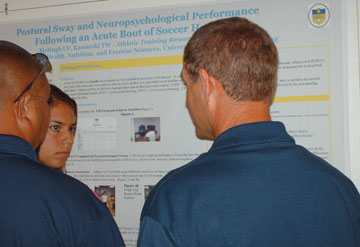 Postural Sway and Neurophysiological Performance Following an Acute Bout of Soccer Heading McHugh LV and Kaminski TW Department of Health, Nutrition, and Exercise Sciences Background: The National High
School Federation (NHSF) recently reported a gain in
soccer participation amongst high school females to over 330,000
players nationwide; pointing to the growing popularity. Soccer is a
contact sport and therefore the participants risk injury, including
head injuries. Interestingly, the activity most frequently associated
with concussions is the act of heading the ball. Alarmingly, females
respond differently to concussions when compared to their male
counterparts. Objective: The purpose of this study is to determine if
there are any changes in concussion symptoms, neuropsychological test
performance, and balance after an acute bout of purposeful soccer
heading in players with and without prior history of concussion.
Methods: A total of 40 female soccer players will be recruited and
divided into four groups based on concussion history. Subjects will
complete a baseline Concussion Symptom Checklist, a computerized
neuropsychological test, and a series of balance tests prior to
performing the first soccer heading session (rotational or linear
heading). During this session they will perform 15 purposeful “headers”
over a 15 minute time frame. Afterwards, the subject will repeat the
baseline tests described above. Following 7 days, subjects will return
for another heading session (rotational or linear heading) utilizing
similar test procedures. Data Analysis: For each subject we will
measure the number of previous concussions, differences in concussion
symptoms pre and post heading, the composite scores from the ImPACT
testing, and the Balance Error Scoring System (BESS) scores. Analysis
of variance (ANOVA) techniques will be used to test within subjects
(type of heading [rotational vs. linear] & time [pre vs. post]) and
between subjects (concussion grouping) data. This project is funded by
a grant from the University of Delaware Women’s Studies Program.
|
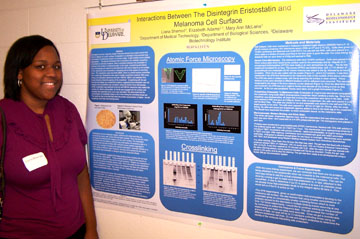 Interactions Between The Disintegrin Eristostatin and Melanoma Cell Surface Proteins Liana Sherrod and Mary Ann Mclane Department of Medical Technology Disintegrins are low molecular
weight molecules derived from snake
venom that bind to integins on a cell’s surface. Eristostatin is a
disintegrin that prevents lung colonization of melanoma cancer in a
murine model. It also inhibits human platelet aggregation. The
actual mechanism that is involved in the inhibition caused by
eristostatin is unknown; however there is confocal evidence that
eristostatin is binding to the surface of melanoma cells. In this
study, Crosslinking and Atomic Force Microscopy are used to try and
determine with which integins on the surface of the melanoma cells
eristostatin is interacting and at what degree of unbinding force. The
crosslinker used was Sulfo-SBED, which is a photo-reactive crosslinker
with a biotin tag. Strepavidin was used to isolate crosslinked
material. With cross linking, we evaluated melanoma cell lines: WM164,
MV3, and platelets from human blood to check the activity of the
crosslinker. Crosslinking with the cell lines did not display any
crosslinked proteins; suggesting that eristostatin was not binding or
the crosslinker was not active. Using the Atomic Force Microscope
(AFM), eristostatin was attached to the tip and WM164 melanoma cells
coated the surface of a 35mm culture plate. As the tip was engaged with
the surface and retracted, and unbinding force curve was calculated. We
determined that the concentration of eristostatin plays a role in how
strong the unbinding forces are. This could be due to the fact that
when the protein is in higher concentration, we are visualizing more
than one binding event.
|
|
A Randomized Blinded Trial of Presurgical Incision Warming for the Prevention of Wound Complications in Women Undergoing Cesarean Section Julia Turner, Sharon Pozzo, Nancy Skinner, and Linda Bucher Department of Nursing The application of heat to skin
tissue has many advantages in the wound
healing process. Raising the tissue temperature promotes a variety of
inflammatory processes, including leukocytosis, drainage, vasodilation,
suppuration, and overall healing. Other studies have demonstrated that
preoperative warming did decrease the incidence of wound infections
following clean surgery. This knowledge laid the foundation for this
research study in which the application of a heating pad prior to a
Cesarean section (C-section) delivery was predicted to decrease the
wound complication rate post procedure. Mothers scheduled for
non-emergent C-sections were invited to participate. Once informed
consent was obtained, subjects were randomized to one of two groups:
routine care which involved no heating pad, or the application of a
heating pad for 30 minutes within two hours of surgery. Subjects were
called two weeks following their surgery to determine any incisional
problems. To date, 161 subjects have been enrolled. Interim data
analysis has shown no significant difference in wound complication
between those subjects who received the heating pad and those who
received standard care. However, the target sample size (N=250) has not
been reached leaving the study underpowered and at risk for a type two
error at this point in time. Supported by INBRE.
|
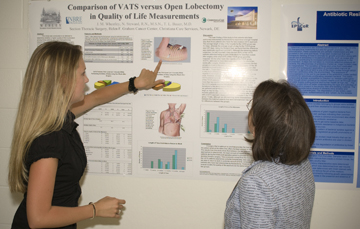 Comparison of VATS versus Open Lobectomy in Quality of Life Measurements J. M. Wheatley, N. Steward, T. L. Bauer Section Thoracic Surgery, Helen F. Graham Cancer Center, Christiana Care Services, Newark, DE This study was conducted in an
attempt to determine whether a higher
quality of life is prevalent among those patients who have had
pulmonary lobectomies using a video-assisted thoracic surgery (VATS)
approach rather than a thoracotomy (THOR) approach. The research was
done by evaluating information available in the Helen F. Graham Cancer
Center thoracic surgery database and by surveying both THOR and VATS
patients on aspects of quality of life. Once the two groups were
finalized, the length of stay was analyzed using the information
provided by the database. The VATS patients had a lower average stay
than the THOR patients, a difference that showed to be statistically
significant (p=0.007). Other collected data that also indicated a
higher quality of life among the VATS patients included the length of
time on pain medications, pain level one week after surgery, and length
of time until able to return to work. The conclusions drawn from this
study indicate that a higher quality of life during the initial
post-operative period exists for patients who have pulmonary
lobectomies via VATS rather than by thoracotomy. Supported by INBRE.
|
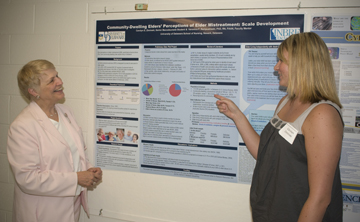 Community-Dwelling Elders’ Perceptions of Elder Mistreatment: Scale Development Carolyn E. Ziminski and Veronica F. Rempusheski Department of Nursing The National Center on Elder
Abuse estimated 1-2 million Americans age
65+ were victims of abuse by a caregiver (2005). Elders are projected
to comprise 20% of the US population in 2030. Frail elders with health
care needs are at greatest risk for mistreatment by their caregivers.
This study aims to elicit perceptions of elders about physical abuse as
a kind of mistreatment. The first phase of the project, presented here,
is the scale development.
Kane’s (1991) family social support theory grounds construction of the
scale and proposes that the more stable a family the more substantial
the reciprocity, advice and feedback, and emotional involvement. This
proposition will guide data interpretation with an assumption that the
less stable the family the more likely they are to have destructive
behaviors. A vignette design with Likert scaling method was chosen for
the construction of the scale because it allows examination of context
(Martin, 2004) while also presenting a sensitive topic in a
non-threatening manner. A 30-item, 4-point Likert scale with three
scenarios, each depicting a living situation is presented. In each
scenario three different abusive themes and three different
barriers to reporting are presented. Respondents rate the
abusiveness of a situation and their likelihood to reporting it.
Perceived definitions and likelihood of reporting are important because
whether or not elder victims would report “abuse” is meaningless
without knowing how elders perceive abuse. Since it is unlikely elders
would self-report (Fulmer et al, 2004), these data are essential to
health care professionals in screening for abuse.
Funding: NIH grant 2 P20 RR016472-08 from NCRR & Buxbaum
Scholarship.
|